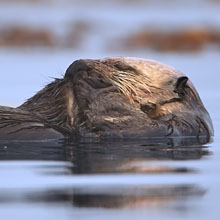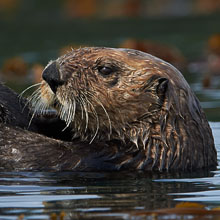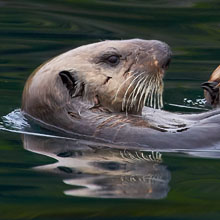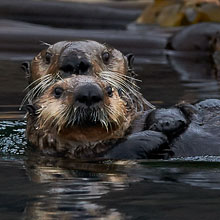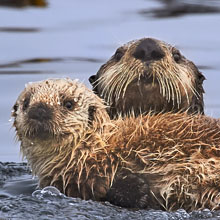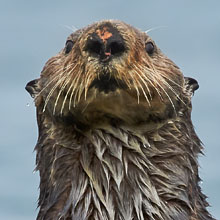Availability: Undetermined - Enquiries?
In the Field
The Water Walker. Northern Vancouver Island, BC, Canada. August 12, 2015.
Like with most animals, the more you know about Sea Otters the more fascinating they become. They're the only marine mammal on earth that doesn't use fat or blubber to help keep them warm while living in a cold, heat-sucking environment. Instead, they rely upon their thick and luxuriant coat as their main defense against hypothermia. And they spend a whole lot of their time grooming that coat - which includes running their front paws through it almost continuously. This preening does at least two things - it helps spread natural oils through the coat, and it fills the thick fur with air, which provides both extra insulation and buoyancy.
Which leads nicely into the title of this image - The Water Walker. The thing that struck me most about this otter was how darned high it could "stand" out of the water. Here the majority of its body is above the water - and it remained in this position (virtually motionless) for a good 20 seconds or more. While the otter's tail and webbed hind feet COULD have been hard at work under the surface thus providing the "lift" for the otter, the absolute stillness of the animal made me think that much of the lift was provided by pure buoyancy of the coat.
This image tells us something else about this otter - that it's likely a female. The scarred up nose is the giveaway - during mating the males climb on the back of the the females and then they reach over and chomp down (quite aggressively) on their "victim's" nose (if you ever saw sea otters mating you'd agree that "victim" is an appropriate term here - if they were humans the male otters would be charged with attempted murder each time they mated). Fortunately the females' noses do heal, and often when you see them with their young they have intact noses again!
This image was captured using a Nikkor 400mm prime lens (the "new" 400mm f2.8E lens) paired with the TC-20EIII (2x) teleconverter. And it's yet one more example why I've become pretty comfortable using the 2x TC on selected prime lenses.
Here's a higher resolution version of the shot (2400-pixel) for your perusal:
• The Water Walker: Download 2400 pixel image (JPEG: 1.3 MB)
ADDITIONAL NOTES:
1. This image - in all resolutions - is protected by copyright. I'm fine with personal uses of it (including use as desktop backgrounds or screensavers on your own computer), but unauthorized commercial use of the image is prohibited by law. Thanks in advance for respecting my copyright!
2. Like all wildlife photographs on this website, this image was captured following the strict ethical guidelines described in The Wildlife FIRST! Principles of Photographer Conduct. I encourage all wildlife photographers to always put the welfare of their subjects above the value of their photographs.
3. This image was captured during my "Humpback, Orcas, Sea Lions & More" photo tour in August of 2015. Each year I offer trips into two different parts of the Great Bear Rainforest as well as one to photograph aquatic mammals and oceanscapes near the northern tip of Vancouver Island. And, in selected years, I also offer photo tours to locations to capture other highly sought-after subjects, such as various owl species of the boreal forest and wildlife of Canada's Arctic. Details about these trips can be found on the Photo Tours page of this website.
Behind the Camera
The Water Walker. Northern Vancouver Island, BC, Canada. August 12, 2015.
Digital Capture; Compressed RAW (NEF) 14-bit format; ISO 1100.
Nikon D750 paired with Nikkor 400mm f2.8E VR plus TC-20EIII (2x) teleconverter (800mm total focal length). Hand-held from floating Zodiac, VR on and in "Sport" mode.
1/2000s @ f8; +0.33 stop compensation from "recommended" matrix-metered exposure setting
At the Computer
The Water Walker. Northern Vancouver Island, BC, Canada. August 12, 2015.
RAW Conversion to 16-bit TIFF using Phase One's Capture One Pro 8. Four raw variants (different versions of a single raw capture) processed, with the variants differing in exposure (0.67 stop total difference between the variants) AND both shadow and highlight recovery settings.
Further digital corrections on resulting 16-bit TIFF files using Adobe's Photoshop CC 2015 and Light Crafts Lightzone. Photoshop adjustments included compositing (blending) of the four output files from the raw converter, minor selective exposure adjustments, minor selective colour saturation and desaturation, and selective sharpening for web output. Final tone-tweaking performed using LightZone's "tonemapper" tool.
Conservation
The Water Walker. Northern Vancouver Island, BC, Canada. August 12, 2015.
Ten percent of the revenue generated by this image will be donated to Raincoast*.
Species Status in Canada**: Special Concern (April 2007) - protected off the North American coast since 1911.
Back in the late 1800's and early 1900's the Sea Otter (Enhydra lutris) was hunted to near extinction along both the Asian and North American Pacific Coasts. The reason? It's luxuriant coat. Otters are unlike any other aquatic mammal in that they don't use fat or blubber to insulate themselves from the chilling effects of the water they are found in. Instead, they rely on their amazingly thick fur coat for insulation. Their amazing coats have a higher density of hair (up to 150,000 strands of hair per square cm!) than any other animal in existence today. To ensure that this coat serves its insulative purpose, otters spend a disproportionately large amount of time grooming their coat (to ensure its natural oils continue to provide an effective waterproof barrier). Unfortunately, the biological functioning of the otters coat can be easily fouled by contamination by oil and other hydrocarbons - thus making them extremely sensitive to the effective of marine oil spills.
Other fascinating aspects of the biology and behaviour of the sea otter include the use of tools (they will use rocks to break apart shellfish such as sea urchins), and the fact that they have an metabolic rate two to three times higher than other mammals of their size. This means they must eat 23% to 33% of their own body weight DAILY, just to to replace the calories burned through maintaining their body temperature in the cold water environment they live in.
*The Raincoast Conservation Society (and Foundation) is an effective and efficient organization that has been fighting for protection of this unique habitat. If you are looking for a meaningful way to contribute to the conservation of this amazing ecosystem, Raincoast will provide maximal "bang" for your conservation dollars.
**as determined by COSEWIC: The Committee on the Status of Endangered Wildlife in Canada



















